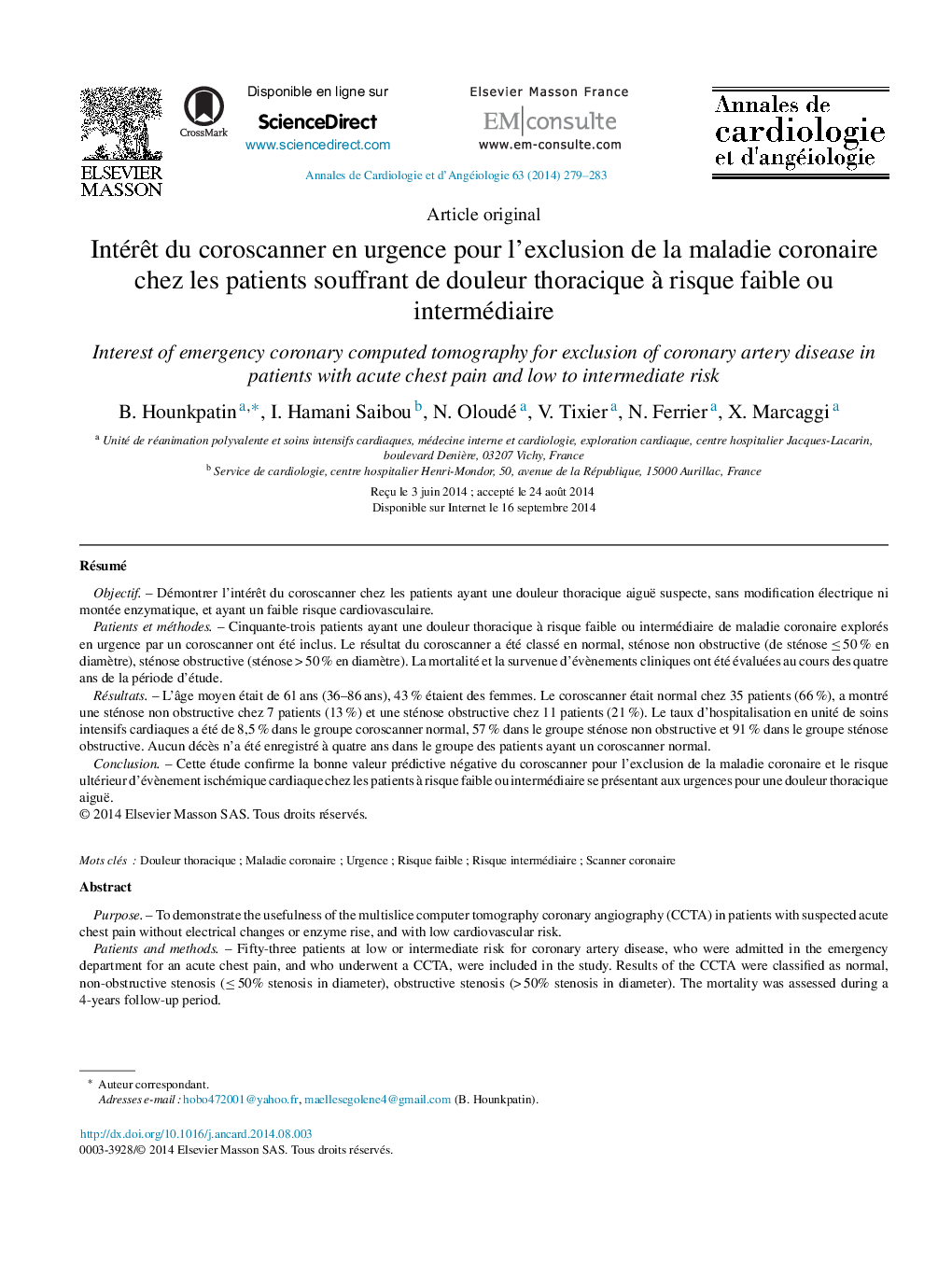| Article ID | Journal | Published Year | Pages | File Type |
|---|---|---|---|---|
| 2868689 | Annales de Cardiologie et d'Angéiologie | 2014 | 5 Pages |
RésuméObjectifDémontrer l’intérêt du coroscanner chez les patients ayant une douleur thoracique aiguë suspecte, sans modification électrique ni montée enzymatique, et ayant un faible risque cardiovasculaire.Patients et méthodesCinquante-trois patients ayant une douleur thoracique à risque faible ou intermédiaire de maladie coronaire explorés en urgence par un coroscanner ont été inclus. Le résultat du coroscanner a été classé en normal, sténose non obstructive (de sténose ≤ 50 % en diamètre), sténose obstructive (sténose > 50 % en diamètre). La mortalité et la survenue d’évènements cliniques ont été évaluées au cours des quatre ans de la période d’étude.RésultatsL’âge moyen était de 61 ans (36–86 ans), 43 % étaient des femmes. Le coroscanner était normal chez 35 patients (66 %), a montré une sténose non obstructive chez 7 patients (13 %) et une sténose obstructive chez 11 patients (21 %). Le taux d’hospitalisation en unité de soins intensifs cardiaques a été de 8,5 % dans le groupe coroscanner normal, 57 % dans le groupe sténose non obstructive et 91 % dans le groupe sténose obstructive. Aucun décès n’a été enregistré à quatre ans dans le groupe des patients ayant un coroscanner normal.ConclusionCette étude confirme la bonne valeur prédictive négative du coroscanner pour l’exclusion de la maladie coronaire et le risque ultérieur d’évènement ischémique cardiaque chez les patients à risque faible ou intermédiaire se présentant aux urgences pour une douleur thoracique aiguë.
PurposeTo demonstrate the usefulness of the multislice computer tomography coronary angiography (CCTA) in patients with suspected acute chest pain without electrical changes or enzyme rise, and with low cardiovascular risk.Patients and methodsFifty-three patients at low or intermediate risk for coronary artery disease, who were admitted in the emergency department for an acute chest pain, and who underwent a CCTA, were included in the study. Results of the CCTA were classified as normal, non-obstructive stenosis (≤ 50% stenosis in diameter), obstructive stenosis (> 50% stenosis in diameter). The mortality was assessed during a 4-years follow-up period.ResultsMean age was 61 years (36–86), 43% of patients were women. The CCTA was normal in 35 patients (66%), seven patients (13%) had non-obstructive stenosis and 11 (21%) had obstructive stenosis. In the group of normal CCTA, 8.5% of patients were admitted in cardiac intensive care unit, 57.1% in the non-obstructive stenosis and 90.9% in the group of obstructive stenosis. No deaths occurred during the 4-year follow up in the group of patients with normal CCTA.ConclusionThis study confirms the negative predictive value of CCTA for the diagnosis of coronary artery disease and for further clinical events in patients at low or intermediate risk referred to emergency department for an acute chest pain.
